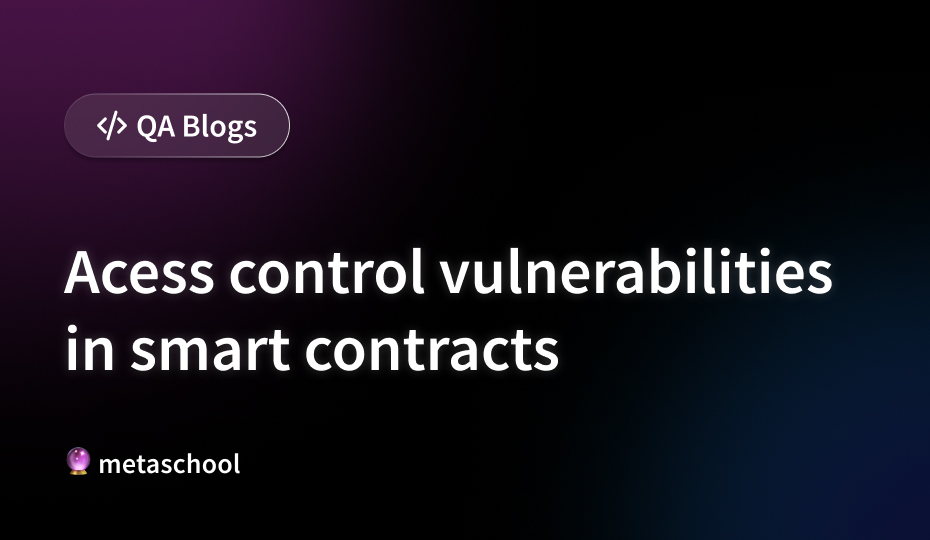Table of Contents
Smart contracts, the self-executing programs powering decentralized applications (dApps) on blockchains, offer immense potential for trustless interactions. However, these powerful tools require robust security measures to function as intended. One critical aspect of security is access control, ensuring only authorized users can interact with specific functions within the contract. Unfortunately, vulnerabilities in access control mechanisms can lead to disastrous consequences, exposing the contract to unauthorized access and manipulation.
Understanding Access Control in Smart Contracts
Access control in smart contracts defines who can call specific functions and perform actions within the contract. This is crucial for maintaining the integrity and intended behavior of the contract. Here’s how access control is commonly implemented:
- Role-Based Access Control (RBAC): This approach assigns roles (e.g., admin, user) to different actors interacting with the contract. Each role has a defined set of permissions, allowing or denying access to specific functions.
- Ownable contracts: Inheriting from an “Ownable” base contract provides a simple access control mechanism where only the contract owner can interact with certain functions.
Common Access Control Vulnerabilities
Despite these access control mechanisms, several vulnerabilities can compromise the security of smart contracts:
- Unchecked External Calls: Sometimes, a smart contract function might call another external contract to perform specific tasks. If the access control on the external contract is not properly validated, an attacker could exploit it to manipulate the external contract through the original contract.
- Privilege Escalation: This vulnerability allows unauthorized users to gain access to restricted functions within the contract. This can happen through flaws in the access control logic, such as missing checks or conditions for role assignment or permission granting.
- Accidental Grants: Incorrect logic within the access control implementation might inadvertently grant unauthorized users access to sensitive functions. For example, a coding error could grant administrator privileges to anyone who interacts with a specific function.
- Denial-of-Service (DoS) via Access Control: Attackers might exploit vulnerabilities in access control logic to trigger functions repeatedly. This can consume excessive gas (computational resources) and hinder legitimate users from accessing the contract, essentially causing a DoS attack.
- Reentrancy and Access Control: While reentrancy attacks typically focus on stealing funds, their effects can be compounded by access control vulnerabilities. A reentrancy attack can exploit a flaw in access control, allowing unauthorized functions to be called repeatedly during the reentrancy window, potentially manipulating the contract’s state for the attacker’s benefit.
Real-World Examples of Access Control Vulnerabilities
Several real-world incidents highlight the devastating impact of access control vulnerabilities:
- The DAO Hack (2016): This infamous attack exploited a flaw in the access control logic of The DAO, a decentralized autonomous organization. The attacker was able to call a function repeatedly, essentially exploiting a recursive call that allowed them to drain funds from the DAO contract.
- Parity Multisig Hack (2017): This attack targeted the Parity Multisig wallet contract, which utilized an Ownable access control scheme. A critical bug allowed anyone to call a specific function repeatedly, effectively locking the contract and preventing legitimate users from accessing their funds.
🔥 Check this course out: Build a One Piece Personality dApp With Solidity
Strategies for Mitigating Access Control Vulnerabilities
Here are some best practices to strengthen access control in smart contracts:
- Least Privilege Principle: Implement the principle of least privilege, granting users only the minimum level of access required to perform their intended actions.
- Thorough Testing: Rigorously test access control logic during development to identify potential vulnerabilities and ensure proper authorization checks are in place for all functions.
- Formal Verification: Utilize formal verification techniques, which involve mathematically proving the correctness of the access control logic, to minimize the risk of vulnerabilities.
- Minimize External Calls: If possible, minimize the reliance on external contracts within your smart contract. This reduces the attack surface and the potential for exploitation through vulnerabilities in external access control mechanisms.
- Security Audits: Regularly engage security firms or experienced developers to conduct thorough audits of your smart contract code, focusing on access control implementations.
Conclusion
Access control vulnerabilities pose a significant threat to the security of smart contracts. By understanding these vulnerabilities, following best practices like the least privilege principle and rigorous testing, and leveraging formal verification and security audits, developers can create robust access control mechanisms for their smart contracts. This helps ensure only authorized users can interact with the contract as intended, fostering trust and security within the decentralized ecosystem. As smart contract technology evolves, prioritizing access control remains paramount for safeguarding user assets and preventing malicious activities.
Ask us questions and tell us how to found the article by tagging Metaschool on Social Media.
Follow us on –
🔮Twitter – https://twitter.com/0xmetaschool
🔗LinkedIn – https://www.linkedin.com/company/0xmetaschool/
